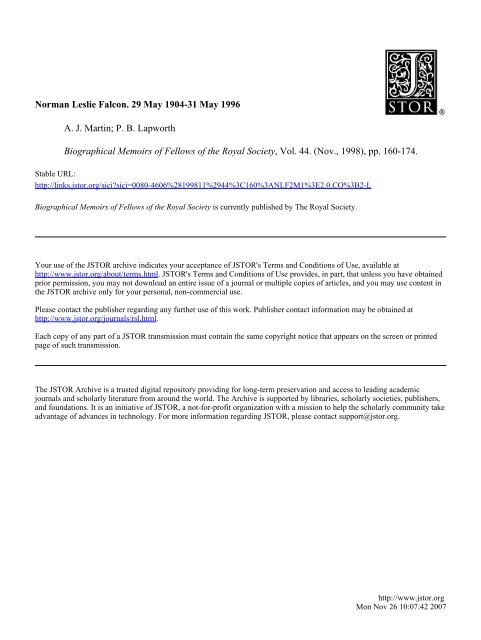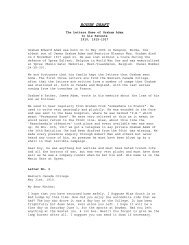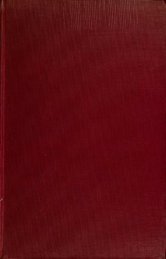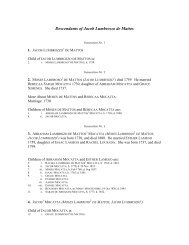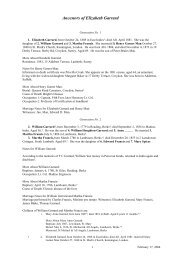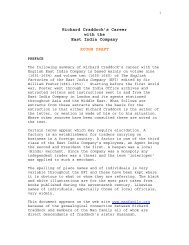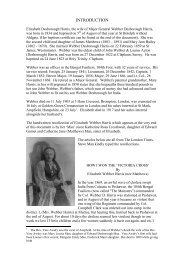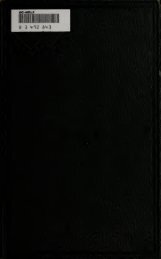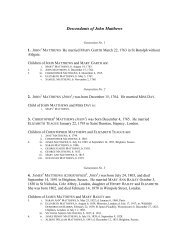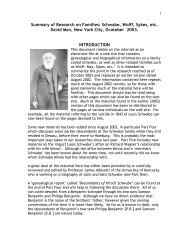Norman Leslie Falcon. 29 May 1904-31 May 1996 A. J. Martin; P. B. ...
Norman Leslie Falcon. 29 May 1904-31 May 1996 A. J. Martin; P. B. ...
Norman Leslie Falcon. 29 May 1904-31 May 1996 A. J. Martin; P. B. ...
- No tags were found...
You also want an ePaper? Increase the reach of your titles
YUMPU automatically turns print PDFs into web optimized ePapers that Google loves.
<strong>Norman</strong> <strong>Leslie</strong> <strong>Falcon</strong>. <strong>29</strong> <strong>May</strong> <strong>1904</strong>-<strong>31</strong> <strong>May</strong> <strong>1996</strong>A. J. <strong>Martin</strong>; P. B. LapworthBiographical Memoirs of Fellows of the Royal Society, Vol. 44. (Nov., 1998), pp. 160-174.Stable URL:http://links.jstor.org/sici?sici=0080-4606%28199811%<strong>29</strong>44%3C160%3ANLF2M1%3E2.0.CO%3B2-LBiographical Memoirs of Fellows of the Royal Society is currently published by The Royal Society.Your use of the JSTOR archive indicates your acceptance of JSTOR's Terms and Conditions of Use, available athttp://www.jstor.org/about/terms.html. JSTOR's Terms and Conditions of Use provides, in part, that unless you have obtainedprior permission, you may not download an entire issue of a journal or multiple copies of articles, and you may use content inthe JSTOR archive only for your personal, non-commercial use.Please contact the publisher regarding any further use of this work. Publisher contact information may be obtained athttp://www.jstor.org/journals/rsl.html.Each copy of any part of a JSTOR transmission must contain the same copyright notice that appears on the screen or printedpage of such transmission.The JSTOR Archive is a trusted digital repository providing for long-term preservation and access to leading academicjournals and scholarly literature from around the world. The Archive is supported by libraries, scholarly societies, publishers,and foundations. It is an initiative of JSTOR, a not-for-profit organization with a mission to help the scholarly community takeadvantage of advances in technology. For more information regarding JSTOR, please contact support@jstor.org.http://www.jstor.orgMon Nov 26 10:07:42 2007
NORMAN LESLIE FALCON<strong>29</strong> <strong>May</strong> <strong>1904</strong>-3 1 <strong>May</strong> <strong>1996</strong>Elected F.R.S. 1960*The Hall, Roudham, East Harling, No$olk NR16 2RL, UKt9 Trinity Churchyard, Guildford, Surrey GUI 3RR, UK<strong>Norman</strong> <strong>Falcon</strong> was a man of intellect, integrity and reserve. His skill, at times almostintuitive, in his chosen profession of petroleum geology was greatly admired and hisjudgement greatly respected by both colleagues and contemporaries alike. He had anunderstanding of his subject that reached out beyond the given wisdom of the day, which inturn could lead him to innovation and boldness in his self-confident application of his science,qualities wanting in workers of lesser calibre. His paramount interest was in the practicalapplication of science, yet he always held a strong interest in and gladly supported theresearch of others. His work therefore was characterized by the application and use of hisexpertise and by giving direction to and supervising others, rather than by the pursuit ofresearch into new realms of geology.His whole career was spent in the employ of The British Petroleum Company and itspredecessors, and it is inevitable that his successful geological career was inextricablyinterwoven with the affairs of the company. The major roles that he played reflect the historyof oil exploration and undoubtedly he helped shape the company's history. BP did not anddoes not exist in industrial isolation, but as part of an enormous global industry. Thus it cantruly be said that <strong>Norman</strong> acted on a world stage and his career helped make, and reflected thefortunes of, that worldwide industry.O 1998 The Royal Society
162 Biographical Memoirs<strong>Norman</strong> <strong>Leslie</strong> <strong>Falcon</strong> was born on <strong>29</strong> <strong>May</strong> <strong>1904</strong> at Braunton, North Devon, the younger sonof Thomas Adolphus <strong>Falcon</strong>, M.A. (Cantab.), R.B.A., and Julie Alice <strong>Falcon</strong> (nbe Schwabe).His younger sister, Elizabeth, survives him. He was directly descended from yeoman farmingstock and the ancestral Cumbrian farm remains in the family. His father was a landscapepainter and silversmith and his mother an accomplished pianist. Together the parents provideda strong artistic background to family life.On 27 January 1938 <strong>Norman</strong> married Dorothy Muriel Freeman, younger daughter of F.G.Freeman of H.M. Consular Service. Dorothy survives <strong>Norman</strong>, as do their three children, JohnAnthony, born in 1939, Michael Geoffrey, born in 1941, and Rosemary Sarah, born in 1945.There are four surviving grandchildren. Both sons were educated at Tonbridge School andTrinity College, Cambridge, and both followed scientific careers. John became a chemicalengineer and Michael an ophthalmic surgeon. Sarah, educated at Benenden School, is marriedand has three children, all of whom share their great-grandparents' artistic interests.Throughout boyhood <strong>Norman</strong> was strongly influenced by his father and together they enjoyedthe countryside and open-air pursuits. After private school, he was educated from 1914 to1923 at Exeter School, eventually becoming headboy. He showed great enthusiasm on thesports field, playing for the school in most field games. His studies were greatly influenced byMr J.N. Bilsborough, B.A., who first aroused <strong>Norman</strong>'s interest in geology.He was never aware of any particular experience fostering an interest in the science butundoubtedly his whole boyhood way of life led him to such an interest. He once recalled thatwalking home from church after singing 'Rock of Ages', he stuck his knife to the hilt into ablock of rock in a drystone wall and thought 'Well, that isn't all that it's made out to be.'The death of his older brother and the development of a stammer from the age of seven marredan otherwise happy boyhood. His impediment gave him an abiding dislike of public speaking andinhibited his acceptance of public oflice. Later in life it did not prevent him from taking a full partin the professional and social world of a petroleum geologist.Like his father, <strong>Norman</strong> went up to Trinity College, Cambridge, in 1923. He obtained FirstClass Honours in Geology to complete his B.A. Cantab. in 1927, and later his MA, havingwon a Senior Exhibition in 1926. Many of his contemporaries at Cambridge becameacademics and the friendships made then became of great importance later. An academiccareer was not one that <strong>Norman</strong> wished to pursue. He recognized that he was most interestedin the application of geology rather than in research. He was also concerned about problemspossibly arising from his speech impediment.At Cambridge his mentors were Professor J.E. Marr, W.B.R. King and his supervisor, T.C.Nicholas. His first excursions abroad were climbing expeditions with L.R. Wager, F.R.S., inthe French Alps. It was Professor Marr who encouraged him to join the Anglo-Persian OilCompany. W.B.R.King, F.R.S, lectured in geology and, importantly for <strong>Norman</strong>, conductedfield work in Arran, the Pennines and the Boulonnais.In 1927 when he was appointed geologist to the Cambridge Edge Island Expedition,Spitzbergen, led by H.G. (Gino) Watkins, his climbing expertise and ability were put to good
<strong>Norman</strong> <strong>Leslie</strong> <strong>Falcon</strong> 163use. The geological results appeared as an Appendix to Watkins's account of the expedition(1)'. In the discussion of the report J.M. Wordie (later Sir James) said how very fortunate theexpedition had been in having such a competent geologist.In late 1927 <strong>Norman</strong> joined the Anglo-Persian Oil Company (APOC). It, and its corporatesuccessors, became his only employer until his retirement in 1965. His early experiences inPersia remained as an ever-present influence on his work and thinking. He left for Persiaalmost immediately on his return from Spitzbergen and arrived by tanker at Abadan on the 1November 1927.The company had met with some success drilling anticlines associated with oil and gasseeps in the Zagros Mountain foothills. By 1927 a better, but incomplete, understanding of theintensely disharmonic nature of the fold-belt and the all-important Miocene AsmariLimestone reservoir had been established. Mapping was still mainly concerned withdelineating individual structures in the foothills of Khuzestan and in parts of Fars. <strong>Norman</strong>'sfirst job was to accompany YP. Wilson in mapping a small anticline near Bushire.Of those first days in Persia <strong>Norman</strong> wrote:I knew next to nothing about oil or South Persian geology, and had only short experience of 6"mapping . . . I was doubtful whether knowledge of the UK Lower Palaeozoic was going to be of muchFigure 1. N.L. <strong>Falcon</strong> in the Iranian Makran on the joint RGSI Imperial College London MakranExpedition 1974-76 (holding his own Makran survey map done in the 1930s).u umbers in this form refer to the bibliography at the end of the text.
164 Biographical Memoirsassistance (it did help) and felt handicapped by abysmal ignorance of the Tertiary. However the Wilsonsurvey proved an invaluable introduction to Zagros foothills geology. I was fascinated by the tribalenvironment with its cheerful and tough inhabitants, still armed, in gaudy tribal dress, not yet undergovernmental control (10).Subsequently <strong>Norman</strong> was sent to be the geologist on three wells at Gach-e-Garaguli (nowGach Saran), Qishn Island and the giant oil and gas complex at Agha Jari and Pazanun.Drilling at that time, using cable-tool technology, was often a tedious matter for a geologist.Recounting his early experiences (10) he recalled that the Gach-e-Garaguli No.3 well blew outbut did not bum. The drilling superintendent burst into <strong>Norman</strong>'s office shouting that it wasall his fault-a judgement with which <strong>Norman</strong> disagreed. <strong>Norman</strong> suggested that they shouldsee for themselves what was happening and verify whether there was a fire, laconicallycommenting 'before I was fired too, which wouldn't have helped very much'.In 1930, APOC took the decision to map the complete Zagros Range at a scale of 4 milesto the inch. This project was lead by J.V. Harrison. <strong>Norman</strong>, who was about to return toEngland on leave, was persuaded to stay and join Harrison. Thus began a partnership of nearlyeight years of fieldwork in difficult mountainous terrain, at the end of which a majorcontribution had been made to mapping nearly 90000 square miles of country, bothgeologically and topographically. Between 1930 and 1937 <strong>Norman</strong> spent almost six years inthe field, broken only by short breaks in Masjid-e-Sulaiman.A topographical surveying team, led by W.E. Browne, worked ahead of the geologists toprovide a critical trigonometric base-map. The geologists' work, the product of carefulobservation with hammer and hand-lens, was plotted on their own topographical base-maps madewith plane-table and range-finder, placed on the trig-point framework of Browne's base-map.Thus <strong>Norman</strong> took part in the mapping of the Zagros Mountains from the Kermanshah areain the north-west (Luristan) south-eastwards through Khuzestan to the Shiraz area in northwestFars Province, passing by Central Fars, and picking up again in south-eastern Fars andthe western Makran east of Bandar Abbas. Not only had this entire region not beensystematically mapped before, but much of the tribal country of the Bakhtiari and Qashqai inKhuzestan and Fars was seen by Westerners for the first time.The territory was covered on foot with mobility provided by horse and mule packs. InLuristan, for example, the party traversed in excess of 2000 miles during the survey. In theMakran camels were substituted for the horses and mules. The relatively lower foothillscountry tended to be mapped in the winter months with the party moving to the 'High' Zagrosin the summer months. Camp life was made as comfortable as possible, bearing in mind theconstant moving and life under canvas for periods of up to 10-1 1 months. <strong>Norman</strong> eagerlytook to the work and mode of living. He enjoyed every aspect of the life and his physicalstamina became legendary. C.A.E. O'Brien writes:.. . I heard much about him from other geologists and through tribal contacts from Kurdistan in thewest, through Bakhtiari country . . . to the Qashqai tribes in the east . . . To the tribes he was consideredremarkable for his physical endurance, being able to work all day and then beat them all back to camp.Indeed in later life he always seemed impervious not only to physical fatigue but also to heatand cold.A full Zagros sucession was identified from the Cambrian to the Tertiary. but little attentionwas paid to the pre-Permian succession. The delineation of the thick (in excess of 5000 m)Permian to Pliocene succession provided the first ordered, reasonably complete and coherent
<strong>Norman</strong> <strong>Leslie</strong> <strong>Falcon</strong> 165insight to this Iranian sector of the Tethyan Province. The Zagros Mountain thrust-front, nowknown to mark the tectonic boundary between the Asian and Arabian Plates, was identified asa major crustal structural feature. This mapping has proved robust and has stood the test oftime. Later surveys, both geological and topographical, supportedby aerial photography, haverefined the maps in many points of detail but have not altered significantly the conclusions ofthe original fieldwork.44. t 4P L4 F E W E 11' 6 54. E 56' 6\ ,'::7 !,-'I 1TEHRANISh E56. NJRISTAN':. , .1II34. N<strong>31</strong>' N-. -- 10- N- ~1-. -.- --SAUDI3ARABIA- - - --d"Ix'\- - ! - - 4. - .*'.
166 Biographical MemoirsOn his return to Britain <strong>Norman</strong> contemplated resignation from the Anglo-Iranian OilCompany (lately APOC) and studying for a medical degree. However, the Chief Geologist ofAIOC, Dr G.M. Lees, F.R.S., persuaded him to stay and employed him in the team set up toexplore the possibilities of onshore oil in the UK. Thus in 1938 <strong>Norman</strong> was sent to a welllocation at Cousland, east of Edinburgh. In the same year, possibly partly because of his lackof enthusiasm for well-site work after the excitement of Iran, he was asked again to work onIranian geology. At this time the use of aerial photography was being developed extensivelyas a new and practical technique by the oil industry. <strong>Norman</strong> was seconded in 1939 to Shellin the Hague for training and to develop the aerial mapping of Iran. He also assisted in theplanning of a projected joint AIOCIShell venture in the geologically difficult country of theMakran Province in southern Iran.In 1938 he had learnt to fly, and this, together with his expertise in aerial photographicinterpretation, was to set the course of his career during the Second World War, which brokeout during his secondment to Shell. In <strong>May</strong> 1940 he managed to board one of the last ships toleave for Britain as the Germans advanced through Holland.WARSERVICE 194045During the 'phoney war' <strong>Norman</strong> and Dorothy bought a house in Woking and he volunteeredfor military service. In the summer of 1940 he was commissioned into the Aerial PhotographyIntelligence Service (APIS) of Military Intelligence. Posted first to G.H.Q. Home Forces atWembley, just as the Battle of Britain started, and later to the Central Intelligence Unit of theRAF at Medmenham-on-Thames, his recent training in the Hague stood him in good stead. AtWembley he was assigned the task of building up 'a disparate group of interpreters into aneffective army section providing intelligence on enemy coastal activities and defences, antiaircraftdefences in occupied Europe, army equipment such as tanks, guns and vehicles, andmilitary establishments ...'.A colleague (E.W. Espenhahn) wrote that:<strong>Norman</strong>'s technical experience, persistence, patience and personal modesty earned the respect of hiscontemporaries and achieved harmonious and efficient results. He ably represented the interests of thesmall army section in the large inter-service R.A.F. unit.. .APIS made a growing contribution as the war progressed and the enemy developed sophisticatedweapons . . . Detection of enemy sites at an early stage was instrumental in limiting their damage . . .Throughout the war years <strong>Norman</strong> <strong>Falcon</strong> made a fundamental impact on the interpretation ofaerial photographs and on the provision of intelligence for the army and other services.In the preparations leading to the <strong>Norman</strong>dy landings, APIS had provided essentialinformation and by the end of the war <strong>Norman</strong> had risen to the rank of Lt Colonel and was incommand of the Joint Services Aerial Photographic Intelligence Unit.After the war he maintained his military connection, serving from 1946 to 1950 in theTerritorial Army as a Major in the Royal Engineers, dealing primarily with matters ofgeological concern.
<strong>Norman</strong> <strong>Leslie</strong> <strong>Falcon</strong>167RETURNTO AIOC 1945-55Peacetime saw <strong>Norman</strong> return to the AIOC offices in London where he picked up the work hehad started on six years earlier developing an exploration programme for the UK. During thewar, active exploration had met with some success in an attempt to find domestic sources ofoil.The post-war programme had limited commercial success but provided an immense wealth ofdata on the subsurface geology of the British Isles, which later was invaluable in the explorationof the North Sea. This work contributed especially to a better understanding of Britishstratigraphy, particularly of the Upper Carboniferous (Coal Measures) of the Midlands (6).In these early post-war years, <strong>Norman</strong> continued to keep closely in touch with Iran, whichremained the main focus of company activity. He worked on various compilation studies,including one on Iranian oil-seeps, which were then still the only sure indicator ofhydrocarbon generation. He visited coastal Fars in early 195 1 as a member of a team planninga drilling campaign in the area.Outside Iran, but still within the Mesopotamian Basin, Kuwait developed as a major newarea of interest in 1946, and through the AIOC interest in the Iraq Petroleum Company (AIOC23.75%) <strong>Norman</strong>'s involvement expanded not only to Iraq but also to the Trucial States,Oman and the East Aden Protectorate. Other areas remained of lesser, and sometimes, ofephemeral interest.In the turmoil that followed nationalization in 195 1, the company was deprived of its mainsource of crude oil and the decision was taken to look worldwide for other reserves. A smallnucleus of geologists worked in London and <strong>Norman</strong> was made Geological Manager in 1953.He reported to and assisted Lees directly in all matters of company exploration which had tobe dealt with in London and which required Head Office approval and authority. He initiateda review of all the major sedimentary basins throughout the world in order that a coherentcompany exploration strategy could be developed. He established a fully staffed geologicallibrary and information service within the London office that could also be used by anyoverseas office. Technical services were established, e.g. in photogeology, for company-wideuse and he recruited a small group of specialists to form the basis of the exploration researchdepartment at the company research centre at Sunbury-on-Thames.During this period he showed his willingness to support and try out new ideas andtechniques that might have a practical value. Captain Jacques Cousteau, with his ship theCalypso, was commissioned at this time to attempt underwater geological mapping in thePersian Gulf. This approach led later to the mapping of the sea floor off Dorset and to Britain'sfirst offshore well in 1961 drilled on an anticline mapped in Lyme Bay.In his role of Geological Manager <strong>Norman</strong> took an active interest in most areas of companyactivity. For example, in Nigeria, where exploration was still in its infancy, he was an activeproponent in encouraging Shell-BP Nigeria to move away from the Cretaceous 'framework'of the Niger Delta and to shift exploration to the Tertiary Delta itself.
168 Biographical MemoirsIn 1955 G.M. Lees died and <strong>Norman</strong> was promoted to the position of Chief Geologist. In thesame year, The British Petroleum Company returned to Iran, holding only a 40% equity in theconsortium that replaced the earlier AIOC monopoly. <strong>Norman</strong> was given the mandate to findalternative oil and gas reserves outside Iran. Thus began a decade that saw BP greatly expandits exploration interests to many other countries, while maintaining a strong link with Iran andits neighbours. This worldwide programme was very successful and much of this success canbe attributed to <strong>Norman</strong>.He had learnt the lesson that to be commercially successful in oil exploration it wasnecessary to explore new potential provinces at an early stage. This high-risk strategy ofpioneering new areas could be costly but was one which BP adopted with great success. It didnot take a large staff to find the largest fields, providing they looked in the right places-atruism expressed by Professor Marr in <strong>Norman</strong>'s Cambridge days (10). The onus on <strong>Norman</strong>was to pick those places. He was able to run the BP exploration programmes on what to othersseemed an impossibly small staff and frequently was looked at askance when tellingcompetitors how few geologists BP employed.As Chief Geologist <strong>Norman</strong> had the final authority in deciding which of the venturesproposed by his technical team to back and then had the task of obtaining boardroom support.His undergraduate association with Sir Maurice Bridgeman, a BP board member and latterlyChairman, who had studied geology with <strong>Norman</strong> at Trinity, no doubt helped in this. Thecompany's success was such that by 1965, when <strong>Norman</strong> retired, it is estimated that BP hadtitle to about 22% of the world's oil reserves outside Soviet Russia. No company before orsince has been in the same position.During the last decade of his career, BP discovered major reserves in Abu Dhabi, Dubai,Qatar, Libya and Nigeria, and saw new major fields discovered in Iran. The work in thePersian Gulf area was perhaps of greatest interest to <strong>Norman</strong> because of past associations withthe region, but the geology did not present the challenge inherent in exploring in completelynew areas. Thus the offshore province of the southern Persian Gulf, covering the discoveriesin Abu Dhabi and Dubai, lay in the extension of the southern Iranian salt dome province, withwhich he was familiar. Onshore discoveries in Abu Dhabi and Qatar similarly lay within thefold-belt pattern of the province which was well understood regionally by the 1950s.The new areas presented many different problems, which were tackled in a methodicalmanner. In countries such as Libya and Arctic Alaska the geological database at the start ofexploration was minimal and often reliable topographical maps did not exist. Great emphasiswas placed on the initial use of geological field parties, with seismic surveys following inthose areas that had been identified as important by the geologists. Drilling would follow andin this way a picture of the regional geology, with some degree of local detail, was formed.Final success often occurred some distance from the area initially chosen to commenceexploration, reflecting the growth in understanding of the geology and a flexibility of thoughtallowing changes of focus. Thus in Libya, the areas of structurally high Mesozoic rocks of theGebel Nefusa in Tripolitania and the Gebel Akhdar in Cyrenaica saw the start of thecompany's programme, but as work proceeded it became centred on the south-eastern end ofthe Cyrenaican Tertiary graben, where the enormous Sarir field, containing in excess of eightbillion (8 000 000 000) barrels of recoverable oil, was found in 196 1.Similarly in Alaska initial work by the company caused it to reject at an early stage the
<strong>Norman</strong> <strong>Leslie</strong> <strong>Falcon</strong>169southern basins of the Gulf of Alaska and the Cook Inlet as places to explore, although smallcommercial fields had already been found in the Cook Inlet. The large Mesozoic basincovering the whole of Arctic Alaska was considered more attractive. Furthermore, relativelyfew companies at the time were active in the area. The same pattern of work was adopted andalthough initial drilling resulted in no commercial success, interest gradually moved, with thegrowth of understanding, towards the coastal Prudhoe Bay area.Although the discovery well was drilled after <strong>Norman</strong> had retired, it was during his last twoyears of office that all the licences were obtained in which BP's share of the field and satellitefields lie. Thus the company holds the largest share of the oil of Prudhoe Bay, the largestoilfield in North America (14000000000 barrels) and a significant share of the Kuparuk Riverfield (4 500000000 barrels) as well as in some of the nearby smaller satellite fields.Experience in the North Sea was different. The huge Groningen gasfield in northernHolland had been discovered and the geology onshore the UK was well known. The potentialwas recognized but rather than bid on the large, obvious structures off the Norfolk coast,<strong>Norman</strong> decided to restrict bids to the northern flank of the basin where it was believed thePermian Rotliegendes sandstone reservoirs would be best developed. Early drillingdiscovered the West Sole gasfield, but the giant fields, in which BP had no share, lay to thesouth.Later the position in the northern North Sea showed a return to successful primaryexploration in that the acreage was obtained on which the giant Forties oilfield lies, but as inAlaska, the discovery well was not drilled until after <strong>Norman</strong>'s retirement.In addition to these reserves of world significance, a steady background of exploration wascarried out that gave rise to contemporary or later commercial discoveries, such as those inColombia, Canada, Papua New Guinea, New Zealand and offshore north-west Australia.Other areas were explored and discarded, such as East Africa, Sicily and Greece. As areflection on the embarassment of riches that the company enjoyed at this time the boarddecided to withdraw from Oman after the first well was dry-a decision later to be regretted.These successes were achieved against a changing background. The end of <strong>Norman</strong>'scareer coincided with a period that saw the beginning of the move from dominantly onshoreto offshore exploration and, shortly before he retired, the company made its first tentative useof digital computers in the acquisition and processing of seismic data. The world of oilexploration in which he had been trained and worked all his professional life, at a time whenthe exploration geologist's role was supreme within the oil industry, was about to change inways that at the time could be barely perceived. Thus the exploration world with which he wastotally familiar and in which he played a notable role, stood at the threshold of great changes.It peaked with success at the time of his retirement-a fitting close to his company career.As Chief Geologist <strong>Norman</strong> read all reports, long or short, that were sent to Head Office.Sometimes they would provoke a written reply and others a passing comment when he andthe author met. Whatever the reaction to a report, he kept an eye on what his staff were doing.Much of his comment related to where any particular piece of work was leading. Practicalvalue was always important and to end a project was as necessary as pursuing it if nousefulness could be shown. Poor work got short shrift. A colleague, J.F. Watson wrote that<strong>Norman</strong> was one '. .. who could spot a humbug a mile away, and who did not suffer foolsgladly'.Not only was work itself important but also its presentation. Periodically he issuedinstructions to all geologists on how work was to be presented. In days when all colouring of
170 Biographical Memoirsdiagrams and maps was by hand, he did not want them produced in a manner that was relianton colour for understanding. Cross-sections had to be drawn in a way that gave a serial andcohesive insight to the structure of the country under study. These directives at times seemedmatters of simple commonsense but experience had told him that a diverse group ofgeologists, left to themselves, could produce a variety of idiosyncratic and irritating workwithout some experienced guidance.He recognized early on in his career in London that administrative matters would occupymuch of his time. He did not relish this, having an antipathy towards bureaucracy, butaccepted it as part of his duty. Partly out of interest and partly to compensate for the time notspent on geological matters he built up a coterie of advisers, drawn from leading academicgeologists, such as Professors Shotton, F.R.S., Hollingworth, Hedberg, Dunham, F.R.S., andGill. Not only would these associates assist in keeping him and his staff abreast withdevelopments in geology, but they also undertook reviews and visits to currently activeexploration areas, and provided independent assessments. These associations, coupled withhis own activities, gave <strong>Norman</strong> a good grasp of contemporary work in Britain and the USA.On retirement, family life and geology remained dominant in <strong>Norman</strong>'s life. Most of thetechnical work that he did was devoted to committees and organizations that had an earthscience orientation. For a number of years he remained an adviser to BP, although he wasnever fully at ease with this arrangement because he believed that younger men should havetheir chance and he did not want to give the impression of interfering.For a period he also worked as an adviser to the Stock Exchange. He was asked to serveon numerous committees, which he did from a sense of duty, if at times somewhat critically.He never seemed to enjoy dealing with administrative matters, while recognizing that they hadto be done. Too much committee work involved simply talking and not achieving.Government-sponsored committees included work for UNESCO, DSIR, NERC, the BritishGeological Survey, the Colonial Geological Survey and Imperial College, London. However,most of his committee involvement was centred on the Royal Society, to which he had beenelected in 1960, and the Geological Society, of which he was a Fellow from 1927, later anHonorary Fellow (1988). Most of the Royal Society committees were earth science-related butalso embraced government research grants and the Royal Society Library.He served both the Geological Society and the Royal Geographical Society well. At theGeological Society he rarely missed a meeting in the days when it held Ordinary GeneralMeetings and was a frequent visitor thereafter. He served on Council twice (1954-58 and1967-70), as Foreign Secretary 1967-70 and as Vice President 1968-70. He expectedcompany geologists as a matter of course to be Fellows and F.G. Larminie recalls that on visitsto Head Ofice from abroad <strong>Norman</strong> always invited the visitor to travel with him to BurlingtonHouse by bus. <strong>Norman</strong> preferred a front upstairs seat so that he could comment on the passingscene where, unintentionally, his loud voice kept not only his guest but the whole of the topdeck entertained.His third great interest was the Royal Geographical Society, to which he donated hisextensive Iranian photograph collection and, of which, he served on the Council (1966-69) andwas a Vice President (1973). He was particularly interested and involved in the RGS Expeditions
<strong>Norman</strong> <strong>Leslie</strong> <strong>Falcon</strong>171Committee. It seemed that as he grew older he felt more at home in the RGS than in theGeological Society. His interest in the Middle East led to his organizing and leading the RGSexpedition to Musandam in 1971-72 at the age of 67. This expedition is regarded as one of theSociety's most successful in recent times. He included in the party geologists, biologists,archaeologists, ethnographers and surveyors. He later told A.J. <strong>Martin</strong> that he would like to seea core-hole drilled in the sea floor of one of the Musandam rias, as such a location might provideevidence of the Pleistocene, possibly catastrophic, flooding of the Arabian Gulf. As a result ofthe Musandam expedition he was invited to join the Imperial College expedition to the IranianMakran where he was able to retrace country he had first mapped in 1936 with J.V. Harrison.<strong>Norman</strong> was also a member of many other societies, all reflecting his interest in the naturalsciences, the oil industry, geography and archaeology. He was a member of the BritishAssociation from 1930 and in 1967 served as President of Section C Geology. Others includedFellowship of the Institute of Petroleum, and memberships of the Geologists' Association, theAmerican Association of Petroleum Geologists, the Petroleum Exploration Society of GreatBritain, the Royal Central Asian Society and the Royal Institution. He strongly supported thePetroleum Exploration Society of Great Britain and frequently attended meetings, where hisachievements were virtually unknown to most of the younger members.Rather like an iceberg the bulk of <strong>Norman</strong>'s publications are not visible as he 'buried most ofhis research in confidential reports' (President, Geological Society 1963). Nevertheless he'did amass a substantial corpus of published work' (Larminie 1997) and the citationaccompanying his election to the Royal Society states that he was 'distinguished for hisresearches in tectonics and stratigraphy in connection with the exploration for oil'. It isunfortunate that these surveys were never published for they contain numerous importantdiscussions on Iranian geology.On becoming Chief Geologist, <strong>Norman</strong> decided to publish the Zagros Mountain mapping.The maps were presented in two series, their publication coinciding with the InternationalGeological Congresses of 1956 and 1964. These became his most important publications andremain the standard geological reference maps for south-west Iran. The first series publishedin 1956 at the 20th Congress in Mexico City was at a scale of 1: 1000000 and covered southwestIran on a set of six sheets. A more detailed series of the same area at a scale of 1:250000was presented in a folio of 16 sheets at the 22nd Congress in Delhi in 1964. Each map wasaccompanied by cross-sections and stratigraphic notes. Additionally the 1 :250000 series wasaccompanied by a separate text giving a brief overview of the stratigraphy and structure thatsupplemented the sheet notes. The two series embody the essentials of the whole Zagros project,consisting primarily of the work of Hanison and <strong>Falcon</strong>, and remain fundamental to any studyof the Zagros Range in particular and to basin development in general.He published a number of general papers dealing with the regional geology and the oilgeology of the Arabian Gulf area. Those dealing with the deeper structure of the area reflecteda particular interest. In this respect one of the most significant papers was 'Major earthflexuring in the Zagros Mountains of south-west Iran (7), which identified the north-southstructural cross-trends to the predominant north-westlsouth-east trend of the Zagros.His Presidential address (8) to Section C of the British Assoociation provided an important
172 Biographical Memoirssummary of Arabian Tethyan geology. Other papers synthesizing regional hydrocarbongeology deal with the UK (6) and Papua New Guinea (1961).He was fascinated by the effects of Recent Tectonism on the landscape and archaeology inIran and he frequently referred to these topics later, both privately and publicly. Other highlightsof his publications illustrate his interest in the Late TertiaryiRecent Tectonism that has given riseto the spectacular gravity collapse and overfold structures along the the flanks of some Zagrosanticlines. The classic paper, written with J.V. Hanison (2), on the gravity-collapse structures ofwestern Fars Province clearly describes the variety and origin of such structures.Harrison and <strong>Falcon</strong> (3, 4) also hlly described the huge Said Marreh Landslide in northwestKhuzestan on the east flank of Kabir Kuh. It was recognized that this landslide had mostlikely been triggered by an earthquake and that it occurred as a single catastrophic event.Other large landslides had been noted in Persia earlier, but Said Marreh remains probably thelargest mapped in the eastern hemisphere, displacing an estimated 17-19 cubic km of rockspread over an area of 166 sq. km.The control by contemporary geological processes on present-day topography and therebyon human settlement and activities was admirably summarized in a paper with G.M. Lees (5)and the subject gave rise to a lifelong interest in the general geography and archaeology ofIran and the Middle East.Although his own published work was marked by quality rather than quantity, he wasconvinced of the necessity for companies to publish the results of their work. In this respect,at that time, BP was an exception among the larger companies. <strong>Norman</strong> encouraged juniorcolleagues to publish the important parts of their work and was convinced that openess indisseminating data was of benefit to both academic and commercial interests.His attitude to freedom of information, written in 1977, stated:It is by the provision of major new facts of stratigraphy and structure that the oil industry makes itscontribution to truth. Although some data may have to be withheld from publication for a time becauseit (sic) represents a financial asset to the owners, the necessity passes and ultimate release is of benefitto all, stimulating further activity. ...We can only keep our sense of proportion in the earth sciences bycollaboration, not fragmentation (9).The earliest award received by <strong>Norman</strong> was the Bronze Star presented by the US Governmentin 1945 for his work in Military Intelligence. His first award as a geologist came in 1952,when he received the Murchison Fund from the Geological Society. The Society subsequentlyawarded him the Murchison Medal in 1963, on which occasion the President said that hiswork in Iran 'was an achievement without parallel in oil company operations'.In 1973 he was made an Honorary Member of the American Association of PetroleumGeologists, an honour rarely given to a geologist from outside the US. Again theaccompanying citation stated that '<strong>Norman</strong> <strong>Falcon</strong> is an outstanding field geologist and hasmade a notable contribution to the geological science and to oil finding'.Honorary membership was also conferred by the Petroleum Exploration Society of GreatBritain in 1980. In addition to recognition of his geological work, he was awarded, again in1973, the Founder's Medal of the Royal Geographical Society, interestingly last awarded to ageologist in 187 1 to Sir Roderick Murchison, F.R.S.
<strong>Norman</strong> <strong>Leslie</strong> <strong>Falcon</strong>173Those who knew <strong>Norman</strong> only in a professional context would think of him as highly intelligent,austere, modest and reserved, with enormous physical energy. Those who knew him better knewthat he was also a kindly man with a wealth of goodwill. The things he loved best were his family,children, the open air, mountains and good health. He was an essentially private person with asmall circle of close friends, while at the same time he enjoyed the company of a wider circle ofcolleagues in whose company he relaxed and with whom his austere manner changed and hebecame open and talkative. Conversations were laced with a dry, brief wit. The same changemarked his retirement. His kindliness was often evident in his defence or good word for someonebeing criticized by others.Perhaps the greatest testimony to his intellect and professional ability was shown by therespect that his geological colleagues held for him. Junior staff can be the fiercest of critics andwhile he was often found in argument and dispute over some aspect of geology, all paid attentionand respect.An autocratic style of management was emphasized by his somewhat withdrawn manner,which in turn resulted partly from an inherent shyness, not helped by his speech impediment. Hewas sympathetic to others' problems, but he complained that to accommodate people's wishes hemust be told of their problems, not appreciating that often his manner did not encourage familiarity.His manner also expressed the high personal integrity that marked his behaviour. He would notcondone nor lend himself to any action that suggested anything other than the highest probity.Mistakes by his staff or corporate associates were one thing; dishonesty clearly another. Thosewho did not know him well could be daunted by this austere and, at times, brusque style whichmade him seem unfriendly and distant. This manner belied his true nature, for he often showedlundnesses to all colleagues. He always supported his staff, if necessary, against all-comers andhad no doubt that BP geologists and geophysicists were as good as any and better than most.This impression of 'distance' was enhanced by his espousal of values that today are somewhatoutmoded, even scorned. Patriotism and loyalty to family and friends, country and company, werestrongly held beliefs that were apparent to anyone who knew him well. A Swiss colleague, Dr E.Lehner, when asked to describe <strong>Norman</strong>, simply replied 'He's very English'.Away from the ofice he was a great family man and was never happier than when in thecompany of his children and grandchildren. He was passionately interested in their activities,proud of their achievements and loved talking about them.In 1960, the family moved from their first home in Wolung to a large Edwardian house withan extensive four-and-a-half-acre garden in Chiddingfold. Here <strong>Norman</strong> enjoyed gardening andhe got much pleasure from woodworking and turning in his own well-found workshop.He wrote (1990) that 'as an oil geologist I have for many years liked to think of the Earth as awhole ... to like Gaia (Lovelock 1979) as a useful hypothesis, because it encourages one not towaste world resources'. Practising what he preached he grew all his own vegetables and fruit andat an early stage he installed a solar panel on his roof and a heat exchanger in the house. He tookpart in community affairs in the village and read extensively. Both he and his wife were strongsupporters of the local Yvonne Arnaud Theatre, which they frequently attended.<strong>Norman</strong> died on <strong>31</strong> <strong>May</strong> <strong>1996</strong>, having led a full, active life, at home and at work, during whichhe certainly gave to society as much or more than he took. Fiercely loyal, with high intellectualand ethical standards, he influenced all for the better, each in different ways. His modesty wassuch that he surely never thought of his life and work in that way. Those who knew him
174 Biographical Memoirsbenefited directly, but many more who did not know him were, and are, in his debt-theof a successful and unselfish life.markSincere thanks are due to the following for their help with the compilation of this Memoir: Mrs Dorothy <strong>Falcon</strong>;Mrs Sarah Aitchison; Dr D.A.L. Jenluns, the late Mr H.R. Warman; Miss Elaine Bimpson; Mrs Bridget Kirbyand many other former colleagues from the BP Exploration Co.; the librarians of the Royal Geographical Society;and other friends and associates too numerous to mention individually but all of whom have given invaluable helpto the authors. Mr F.G. Larminie kindly read the text and made many helpful comments and suggestions.The south-west Iran Harrison-<strong>Falcon</strong> Field Surveys Map is reproduced with the kind permission of <strong>Martin</strong>Moffatt Ltd. The photograph of <strong>Norman</strong> <strong>Falcon</strong> in the Iranian Makran on the joint RGSflmperial College,London, Makran Expedition in ca. 1975 is reproduced with the kind permission of C. Vita-Finzi. Thefrontispiece photograph, taken in 1984, was given to the Royal Society by the Godfrey Argent Studio and isreproduced with their kind permission.REFERENCESTO OTHER AUTHORSGray, K.W. 1961 The geological results of exploration in westem Papua 1937-61 by the AustralasianPetroleum Co. Ltd. J. Geol. Austr. 8, 1.Larminie, F.G. 1997 Obituary-<strong>Norman</strong> <strong>Leslie</strong> <strong>Falcon</strong>. Geogrl J. 163, 344-345.Lovelock, J.E. 1979 Gaia, a new look at life on earth. Oxford University Press.The following publications are those referred to directly in the text. A full bibliographyappears on the accompanying microfiche, numbered as in the second column. A photocopy isavailable from the Royal Society Library at cost.1928 Appendix 111: Geology. In Watkins, H.G. The Cambridge Expedition to Edge island(Spitzbergen). Geogrl J. 72, 134-139.1936 (With J.V. Harrison) Gravity collapse structures and mountain ranges, as exemplified insouth-westem Iran. Q. J1 Geol. Soc. Lond. 92, 91-102.1937 (With J.V. Harrison) The Saidmarreh landslip, south-western Iran. Geogrl J. 89, 4247.1938 (With J.V. Harrison) An ancient landslip at Saidmarreh in south-western Iran. J. Geol.46,<strong>29</strong>6-309.1952 (With G.M. Lees) The geographical history of the Mesopotamian Plains. Geogrl J. 118,24-39. (Additional notes Geogrl J. 122, 399401 .)1960 (With P.E. Kent) Geological results of petroleum exploration in Britain 1945-57. Mem.Geol. Soc. Lond. no. 2.1961 Major earth-flexuring in the Zagros mountains of south-west Iran. Q. J1 Geol. Soc. Lond.142,367-376.1967 The geology of the north-east margin of the Arabian basement shelf. PresidentialAddress, Section C, BAAS, Leeds, 4 September 1967. Advrnt Sci. 24, <strong>31</strong>42.1977 Ignorance below our feet. In The encyclopaedia of ignorance (ed. R. Duncan & M.Weston-Smith), pp. 41 8422. Oxford: Pergamon Press.1979 How it was in Persia. Br. Geol. 4, 90-93.
Biographical Memoirs of Fellows of the Royal SocietyPlease Note: The following pages for this article were scanned frommicrofiche. Although the original microfiche images were not of highestquality, JSTOR has made a best effort to present the material in legiblecondition. Please contact jstor-info@umich.edu if you have any questions.Please click on "Next Page" (at the top of the screen)to begin viewing this article.
<strong>Norman</strong> <strong>Leslie</strong> <strong>Falcon</strong> Bibliography Volume 44 (1998)
BIBLIOGRAPHY Edge Island. Camh.Rev. 14 October 1927 Appendix 1II:Geology.In The Cambridqe Expedition toEdqe Island (Spitzberqen) by H.G.Watkins.Geoqr1. J..-72,134-139.The Bakhtiari Mountains of south-west Persia.Alp.J. --46,351-359.(With J.V.HARRISON) Collapse structures.Geo1.Maa. -71,15<strong>29</strong>-1539.(With J.V.HARRISON) Gravity collapse structures and mountain ranges,as exemplified in south-western 1ran.P.Jl.geol.Soc.Lond. %,91-102. (With J.V.HARRISON) The Saidmarreh landslip,south- west Iran. Geoqr1.J. 89.42-47. (With J.V.HARRISON) An ancient landsli~ at ~aidmarreh in south-western 1ran. J .~eoi. 46,<strong>29</strong>6- 309. Water supplies in 1raq:the Kehariz.Geoqr1.J. 93,277-278.The evidence for a former glaciation in the south- western Persian mountain belt.Geogr1.J. 107,78. Major clues in the tectonic history of the Malverns Geol.Maq. 84,2<strong>29</strong>-240. Raised beaches and terraces of the Iranian Makran coast.Geoqrl.3. 109,149-151. (With P Z.KENT) Chalk rock of Dorset - moreevidenie of salt? Geol.Maq. 87,302-303.(With L-H-TARRANT) The gravitational and magnetic exploration of parts of the Mesozoic-covered areas of-south-centrai England.Q.Jl.qeo1.Soc.Lond. 106, 141-170. (With G.M.LEES) The geographical history of the Mesopotamian Plains.Geoqr1.J. =,24-39.(Adbitional notes.Geoqr1.J. 122,399-401.) Results obtained from the borehole drilled by D'Arcy Exploration Co.at Farringdon (Shellingford), Berkshire.Proc.-geol.Soc. no.l524,pp93-95. (Obituary) G.M.Lees.Proc.qeo1.Soc. no.l5<strong>29</strong>,pp142- 145.
(Obituary) G.M.Lees.Geoqr1.J. 121,252-253. (Obituary) P.F.Hutchins.Proc.geol.Soc. no.1541, ppl37-138. The position of the oilfields of south-west Iran with respect to the relevant sedimentary basins.In Habitat of Oil, pp1279-1<strong>29</strong>3.Tulsa:Am.Assoc.Pettol. Geol.Symp. Reserves fundamental to the industry's growth.(Fin. Times World Oil Survey). Tear (or transcurrent)faults.Contribution to symposium on continental drift.Roy.Astron.Soc. (Geophys.Sect.) London.27 November 1959. (With P.E.KENT) Geological results of petroleum exploration in ~ritain 1945-57.Mem.~eol.Soc.Lond. no.2. Major earth-flexuring in the Zagros mountains of south-west Iran. Q.Jl.geol.Soc.Lond. 142,367-376. (Obituary) K.Washington Gray.Proc.qeol.Soc. no.l61l,pp143-144. Equal areas of Gondwana and Laurasia.Nature(London) 213,580-581 .The geology of the north-east margin of the Arabianbasement shelf.Presidentia1 Address,Sect.C,Brit.Assoc.Adv.Sci.Leeds,4 September 1967.Advmt.Sci. 24,<strong>31</strong>-42.(With J.V.HARRISON) Is the Zagros fault line of Iran a wrench fault? Geol-Maq. =,608(corresp.). Problems of the relationship between surface structure and deep displacements illustrated by the Zagros range.In Time and place in oroqeny.Geol.Soc. Lond.Spec.Publ.no.3. Vincent Charles 1lling.Bioqr.Mem.Fell.R Sw. 16,365-384.Introduction to The structure and evolution of the Led Sea and the nature of the Red Sea,Gulf of Aden and Ethiopia rift lunction(A discussion organised by N.L.<strong>Falcon</strong>,I.G.Gass,R.W.Girdler and A.S.Laughton) Phil.Trans.R.Soc.Lond. A =,5-7.
(Obituary) E.Blackwelder.Proc.qeol.Soc.no.1662,pp 101-102. The geological background to geomorphology.Review of Rocks and relief by B.W.Sparks.London:Longman. Geoqr1.J. 137,395-398. George <strong>Martin</strong> Lees.Dict.Natn.Bioqr. 1951-60,pp617. Oxford University Press. Expedition t3 unknown Musandam.Geoq.Maq. 45,105-111 Oil in its true proportions.Geog.Mag. 45,187-190. Exploring for oil and gas.In Modern petroleum technoloa,pp26-66.London:Halsted Press,Applied Science Publishers for Institute of Petroleum. The Musandam (northern Oman) expedition 1971-72. Ge0qr.J. m,1-19. An outline of the geology of the Iranian Makran. Ge0gr.J. 140,284-<strong>29</strong>1. From Musandam to the Iranian Makran.Geoqr1.J. 141, 55-58. Ignorance below our feet. In The encyclopedia of iqnorance (ed.R.Duncan and M.Weston-Smith),pp 418- 422.0xford:Pergamon Press. How it was in Persia.Br.Geo1. 4,90-93. William George Fearnsides.Dict.Natn.Bioqr. 1961-70, pp 351-352.0xford University Press. Vincent Charles Illing.~ict.Natn.Bio~r.1961-70,pp 561-562.0xford University Press. Exploring for oil and gas.In Modern petroleum technoloay15th ed.pp<strong>29</strong>-72.London:Halsted Press, Applied Science Publishers for Institute of Petroleum. (With SIR KINGSLEY DUNHAM) Percy Edward Kent.Bioqr.Mem.Fell.R.Soc. 33,345-373.BP publications initiatad and supervised by N.L.<strong>Falcon</strong>. 1950 BPI Explanatory text to geological air photographs of south-west Persia. Transparent overlays showing
geological boundaries and coloured miniature geological location maps and sections.(Photographs by Huntings Aerosurveys,geology compiled from work of Anglo-Persian/Anglo-Iranian Oil Cos.;printed by Edward Stanford,Long Acre,London for British Petroleum Co-Ltd.) 1956 BP2 Geological maps and sections of south-west Persia with explanatory notes. Maps 1:l million,6 sheets. Compiled from work of Anglo-Persian Oil Co.1909-33 and Anglo-Iranian Oil Co.1933-51 geologists, dedicated to Dr.G.M.Lees Chief Geologist 1932-55. (Presented by the British Petroleum Co.Ltd.,20th Int.Geol.Congr.,Mexico,1956.) 1961 BP3 Geological results of petroleum exploration inwestern Papua 1937-61 by the Australasian PetroleumCo.Ltd.(ed.K.Washington Gray).J.Geol.Soc.Austr. 8,no. 1.1964 BP4 Geological rnaps,columns and sections of the High Zagros of south-west Iran (with pamphlet 4pp,map 1:250,000,16 sheets).(Presented by the British Petroleum Co.Lttd.,22nd Int.Geol.Congr.,Delhi,1964)


